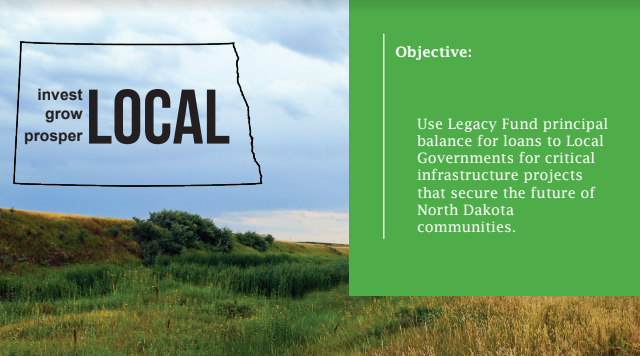What if North Dakotans Started Financing Infrastructure by Lending Money to Themselves?

In 2009 the North Dakota Legislature passed a constitutional amendment to create a fund out of a portion of taxes on oil and gas development. It was passed by the voters in the 2010 election, and the result is the Legacy Fund which has a balance of going on $5 billion. It’s projected to have around $6 billion by the end of the current biennium.
The Legacy Fund is invested currently, with a big chunk of those investments being bonds issued to political subdivisions around the country for various infrastructure projects (see the most recent annual report from the State Investment Board here).
Now a group of lawmakers have asked, if we’re going to invest Legacy Fund dollars into funding infrastructure, why not invest it in North Dakota infrastructure? And if we’re going to loan ourselves money for infrastructure, why not give ourselves a low interest rate?
Those lawmakers, led by Senator David Hogue and Rep. Roscoe Streyle (both Republicans from Minot), are introducing legislation that would make 15 percent of the Legacy Fund available to capitalize a revolving loan program for specific types of infrastructure projects:
- Flood control and protection
- Water and wastewater treatment plants
- Regional water supply
- Municipal water supply
- Airport authority
The program would start in the 2019 – 2021 biennium. The maximum term of any loan issued out of the program would be 50 years, and the interest rate would be capped at 1.56 percent. The minimum loan amount would be $10 million, or $1 million on refinancing. The state-owned Bank of North Dakota would be responsible for underwriting the loans.
Only 15 percent of the Legacy Fund would be available for this.
You can see the draft legislation below, as well as an informational PDF they’re distributing here.
I was never a fan of the Legacy Fund. When it was created it was a very pie in the sky idea. I didn’t like the idea of taking billions of dollars from the private sector and locking it up in a fund with no defined public purpose. But most North Dakotans disagreed with me, and now we have a fund with billions of dollars in it.
Since that’s the case, this seems like a great idea for leveraging those dollars in a way that serves the public very well.
The potential benefits to this program are enormous.
The cost of borrowing for infrastructure projects financed through this program would be dramatically lower. Not only is the capped interest rate lower than the going market rates, but the underwriting and broker fees would be eliminated. That, in turn, means these infrastructure projects are less of a financial burden on taxpayers.
That also means infrastructure in North Dakota is easier to build. Which makes our state a more attractive to business or industry wanting to locate here.
All of which is accomplished without spending the principal of the Legacy Fund itself. These are loans. They’d be paid back. With interest.
I think we can expect critics of the idea to argue that issue low-interest loans has an opportunity cost for the Legacy Fund. To be sure, the funds used for these loans could draw a better return if invested in different ways.
But what’s our goal with the Legacy Fund? To maximize return on investment or to use the funds we’re accumulating to serve our state?
I had Rep. Streyle on my radio show today about this topic (get the podcast) and one question a listener wondered about was why roads weren’t one of the areas of infrastructure available for these loans. “Because there’s an infrastructure fund already and the main large scale projects left to do are related to areas addressed.,” Streyle told me in a text after the show (we got the question after the interview). “I wouldn’t be opposed to including but most large scale road projects are state and federally funded primarily.”
Here’s the draft legislation. It’s a very intriguing idea, and I’ll admit that at first blush I like it.
[scribd id=373040904 key=key-LU4OUonZS8bS26f22C0S mode=scroll]




